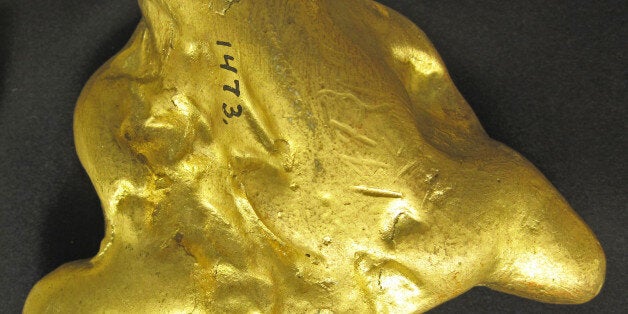
Επιστήμονες στην Ελβετία δημιούργησαν χρυσό ελαφρύ σαν αφρό, που επιπλέει στο νερό. Αν και είναι περίπου 20 καρατίων, το 98% είναι αέρας και μπορεί άνετα να επιπλέει στο αφρόγαλα ενός καπουτσίνο! Πρόκειται για την ελαφρύτερη μορφή οποιουδήποτε πολυτίμου μετάλλου έχει ποτέ παραχθεί μέχρι σήμερα.
Ο χρυσός-αφρός είναι χίλιες φορές πιο ελαφρύς από τον κανονικό χρυσό, παρόλα αυτά είναι σχεδόν αδύνατο να καταλάβει κανείς τη διαφορά με γυμνό μάτι, καθώς έχει το χαρακτηριστικό χρώμα και τη γνωστή μεταλλική λάμψη του χρυσού. Αν τον πιάσει όμως κανείς, είναι πιο μαλακός και εύπλαστος.
Οι ερευνητές του Ελβετικού Ομοσπονδιακού Ινστιτούτου Τεχνολογίας (ΕΤΗ) στη Ζυρίχη, με επικεφαλής τον καθηγητή Ραφαέλε Μετσένγκα, έκαναν τη σχετική δημοσίευση στο περιοδικό για νέα υλικά «Advanced Materials».
Το νέο πορώδες υλικό αποτελείται από 98 μέρη αέρα και δύο μέρη στερεού υλικού. Από αυτό το στερεό υλικό, τα τέσσερα πέμπτα είναι καθαρός χρυσός και το υπόλοιπο ένα πέμπτο είναι πρωτεΐνη γάλακτος.
Το ασυνήθιστο υλικό αποτελεί μια μορφή αερογέλης, ελαφρύτερη από το νερό και σχεδόν τόσο ελαφριά όσο ο αέρας. Η διαφορά μιας υδρογέλης από μια αερογέλη (ή αεροπήκτωμα) είναι ότι το υγρό της πρώτης αντικαθίσταται από αέρα, ενώ διατηρείται η δομή του υλικού.
Οι ερευνητές αρχικά θέρμαναν πρωτεΐνες γάλακτος για να παράγουν ίνες πάχους μερικών νανομέτρων, τις οποίες μετά τοποθέτησαν σε ένα διάλυμα με άλας χρυσού. Οι ίνες δημιούργησαν ένα πλέγμα, πάνω στο οποίο συγκεντρώθηκαν κρύσταλλοι (νανοσωματίδια) χρυσού, με τελικό αποτέλεσμα μια χρυσή αερογέλη.
Οι ερευνητές δήλωσαν ότι ο πανάλαφρος χρυσός θα μπορούσε να βρει πρακτικές εφαρμογές εκεί όπου χρησιμοποιείται ήδη ο κανονικός χρυσός, ακόμη και για την κατασκευή χρυσών ρολογιών και κοσμημάτων. 'Άλλες πιθανές εφαρμογές είναι η χρήση του ως καταλύτη σε χημικές αντιδράσεις, στην παραγωγή ηλεκτρικών αισθητήρων πίεσης κ.α.
(Με πληροφορίες από ΑΠΕ - ΜΠΕ)